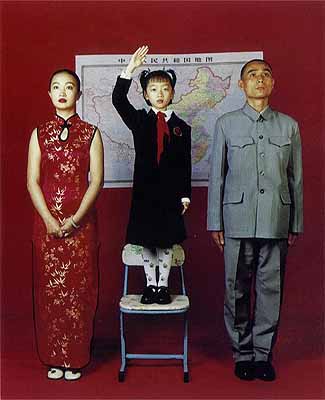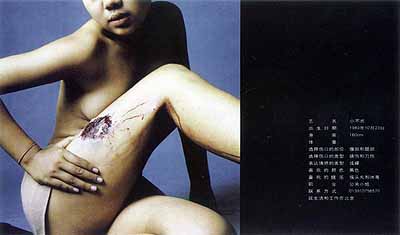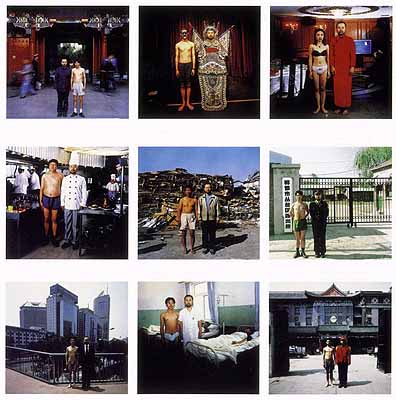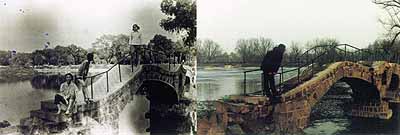
A Strange Heaven - Contemporary Chinese Photography
HE An » ZHAO Bandi » HAI Bo » Chien-Chi Chang » Leung Chi-Wo » CHEN Chieh-Jen » CHING Chin-Wai » WENG Fen » JIN Feng » YANG Fudong » YUAN Goang-Ming » ZHENG Guogu » HONG Hao » ZHUANG Hui » HU Jieming » WANG Jinsong » YAO Jui-chung » HAN Lei » HONG Lei » CHEN Lingyang » MA Liuming » Feng Mengbo » WANG Ningde » Wang Qingsong » RongRong & inri » WU Shanzhuan » SHAO Yinong & MU Chen » ZHAO Shaoruo » CHEN Shaoxiong » LIN Shu-min » CHEN Shun-chu » LIN Tianmiao » WU Tieng-Chang » WU Tieng-Chang » HUNG Tung-Lu » LIU Wei (*1972) » Ai Weiwei » WU Shanzhuan & Inga Svala Thorsdottir » ZHOU Xiaohu » CANG Xin » Yin Xiuzhen » HUANG Yan » SHI Yong » SONG Yongping » LIU Zheng » QIU Zhijie »
Exhibition: 4 Sep – 29 Nov 2003
Galerie Rudolfinum
Alsovo nabrezi 12
110 00 Praha
+420 22-7059205
galerie@rudolfinum.org
www.galerierudolfinum.cz
Tue-Sun 10-18

Chinese contemporary art literally burst onto the international art scene in the early 1990s and since then has achieved a firm position within today's art world. Chinese artists participate in big international exhibition events; foremost museums and institutions organise exhibitions of Chinese visual art; individual shows of Chinese artists are often shown in museums and galleries all over the world. However, attention is almost always focused on painting, installation, or videoart, and less on sculpture or photography. If the history of development of contemporary Chinese art is not long, the history of art photography as an independent visual art discipline in China is even shorter. The great artistic potential of China today has employed the photographic medium only since the early 1990s which is where the origin of art photography as an independent art discipline dates back to. It was not before the 1990s that photography gained the reputation of a serious art activity equalling other artistic concepts and trends and became the principal medium of expression for many Chinese artists. The belated appearance of photography among visual art media (at first mainly in conceptual works) is probably due to the only recently discovered and ever rising self-consciousness of contemporary art in China. Moreover, Chinese photography, as well as all Chinese art in the 1990s, has been shaped by a painstaking effort of losing memory, rooted in the will to cut ties with the harmful past. The exhibition "A Strange Heaven", Contemporary Chinese Photography, is a result of two-years collaboration by the curators Chang Tsong-zung of Hong Kong and Petr Nedoma, the Director of the Galerie Rudolfinum. "A Strange Heaven" links up with the long-term effort of the Galerie Rudolfinum to document the contemporary art activities of the Asian Pacific region. The exhibition presents works by more than 40 artists from China, Hong Kong and Taiwan, only 3 of whom live abroad. The 200+ works on show include more than 1000 photographs. In this large-scale exhibition we have an opportunity to encounter the reality of contemporary Chinese art across political borders, which makes "A Strange Heaven" probably the first exhibition of its kind ever to be held in Europe. It is the first attempt at a crossover selection aimed at showing the immense artistic potential of China today. The title of the exhibition, "A Strange Heaven", relates to the ancient Chinese idea of five cardinal points: apart from the usual four there is the fifth one heading upwards, so that all life on the Earth takes place below Heaven. The exhibition is accompanied by a number of events and programs designed to present to the Czech audience the different spiritual background of a country which finds itself in the midst of a process of deep change and re-thinking of its own tradition and past as seen from different perspectives. Curators: Chang Tsong-zung (Hong Kong) Petr Nedoma (Galerie Rudolfinum)

